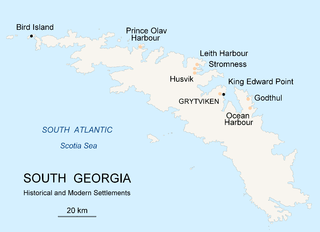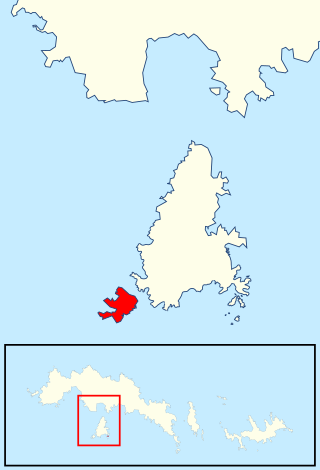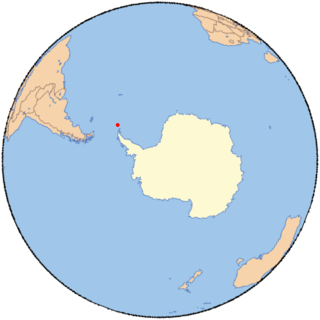Related Research Articles

Signy Island is a small subantarctic island in the South Orkney Islands of Antarctica. It was named by the Norwegian whaler Petter Sørlle (1884–1933) after his wife, Signy Therese.

Coronation Island is the largest of the South Orkney Islands, 25 nautical miles (46 km) long and from 3 to 8 nautical miles wide. The island extends in a general east–west direction, is mainly ice-covered and comprises numerous bays, glaciers and peaks, the highest rising to 1,265 metres (4,150 ft).
The Larsen Islands are a small group of islands north-west of Moreton Point, the western extremity of Coronation Island, in the South Orkney Islands of Antarctica. They were discovered by Captains George Powell and Nathaniel Palmer on the occasion of their joint cruise in December 1821. The islands were named on Petter Sørlle's chart, based upon his survey of the South Orkney Islands in 1912–1913, in honour of Carl Anton Larsen.

Prince Olav Harbour is a small harbour in the south west portion of Cook Bay, entered between Point Abrahamsen and Sheep Point, along the north coast of South Georgia.
Barff Peninsula is a peninsula forming the east margin of Cumberland East Bay, South Georgia Island. It is 8 miles (13 km) long and extends northwest from Sörling Valley to Barff Point, its farthest extremity. It was probably first seen by the British expedition under James Cook in 1775. The peninsula as a whole takes its name from Barff Point, which was named for Royal Navy Lieutenant A.D. Barff of HMS Sappho, who, assisted by Captain C.A. Larsen, sketched a map of Cumberland Bay in 1906. Barff Point is considered the eastern headland of East Cumberland Bay.
Cape Ingrid is a dark rock promontory separating Norvegia Bay and Sandefjord Cove on the west side of Peter I Island, Antarctica. It was discovered in 1927 by a Norwegian expedition under Eyvind Tofte in the Odd I, a vessel of Lars Christensen's whaling fleet, and named for Ingrid Christensen, the wife of Lars.
Esbensen Bay is a small bay 1 nautical mile (2 km) southwest of Nattriss Head, along the southeast end of South Georgia. It was charted by the Second German Antarctic Expedition, 1911–12, under Filchner, and was named for Captain Viktor Esbensen, manager of the Compañía Argentina de Pesca whaling station at Grytviken, the first land-based whaling station in Antarctica.
Borge Bay is a large, irregularly-shaped bay that dominates the east side of Signy Island, in the South Orkney Islands of Antarctica. It was charted in 1912 by Norwegian whaling captain Petter Sorlle, and named for Captain Hans Borge of the Polynesia, who undertook additional mapping of the bay during the following year. It was charted in more detail in 1927 and 1933 by Discovery Investigations personnel, who named many of its features. It was surveyed further in 1947 by the Falkland Islands Dependencies Survey (FIDS), which named several other features.
Fulmar Bay is a bay 1 nautical mile (2 km) wide between Moreton Point and Return Point at the west end of Coronation Island, in the South Orkney Islands. It was first sighted and roughly charted by Captain George Powell and Captain Nathaniel Palmer on their joint cruise in December 1821. It was surveyed in 1933 by Discovery Investigations personnel, and so named in 1954 by the UK Antarctic Place-Names Committee because large numbers of Antarctic Fulmars nest in this area.

Moe Island is an island 2 km (1.2 mi) long in the South Orkney Islands off Antarctica, separated from the south-west end of Signy Island by Fyr Channel. It was charted by Captain Petter Sørlle in 1912–13, and named after M. Thoralf Moe of Sandefjord, Norway, a contemporary whaling captain who worked in this area. The northernmost point of the island is Spaull Point, named by United Kingdom Antarctic Place-Names Committee (UK-APC) after Vaughan W. Spaull, British Antarctic Survey (BAS) biologist on Signy Island, 1969.
The Monk Islands are a group of very small islands and rocks lying 1.5 nautical miles (3 km) south of Meier Point, off the south coast of Coronation Island in the South Orkney Islands off Antarctica. They were first charted and named "Munken" by Norwegian whaling captain Petter Sørlle in 1912–13. The name approved is an anglicized form of the earlier Norwegian name appearing on the chart by Discovery Investigations personnel on the Discovery II, who surveyed the islands in 1933.

Gerd Island is an island 1 nautical mile (2 km) west-southwest of Stene Point at the east side of the entrance to Norway Bight, off the south coast of Coronation Island in the South Orkney Islands. It was charted and named by Norwegian whaling captain Petter Sorlle, who made a running survey of the South Orkney Islands in 1912–13.

Moreton Point is a point 1 nautical mile (2 km) north of Return Point at the western end of Coronation Island, in the South Orkney Islands off Antarctica. It was roughly charted by Captains George Powell and Nathaniel Palmer in 1821, and was named by Discovery Investigations personnel on the Discovery II who charted the islands in 1933.

Mikkelsen Harbour is a small bay indenting the south side of Trinity Island between Skottsberg Point and Borge Point, in the Palmer Archipelago, Antarctica. It provides excellent anchorage for ships, and was frequently used by sealing vessels in the first half of the nineteenth century and by Norwegian whaling vessels at the beginning of the twentieth century.
Sandefjord Peaks is a set of three conical peaks, the highest 635 m, marking the southwest end of Pomona Plateau at the west end of Coronation Island, in the South Orkney Islands. The southernmost of these peaks was named Sandefjord Peak after nearby Sandefjord Bay by DI personnel in 1933. The collective name, Sandefjord Peaks, was recommended by the United Kingdom Antarctic Place-Names Committee (UK-APC) following a survey of the peaks by the Falkland Islands Dependencies Survey (FIDS) in 1950. They were first climbed in September 1969 by John Edwards, Martin Pinder, Dave Rinning and Eliot Wright after 11 days man-hauling a sledge across from Signy Island
Sandefjord Ice Bay is an ice bay about 25 nautical miles (46 km) wide which forms the head of Prydz Bay. The feature is bounded on the west by Amery Ice Shelf, on the east by Publications Ice Shelf, and on the south by the mainland.
Sandefjord Cove is a cove between Cape Ingrid and the terminus of Tofte Glacier on the west side of Peter I Island. A Norwegian expedition under Eyvind Tofte circumnavigated Peter I Island in the Odd I in 1927. In February 1929, the Norvegia under Nils Larsen carried out a series of investigations all around the island, landing on February 2 to hoist the Norwegian flag. The cove was named for Sandefjord, Norway, center of the Norwegian whaling industry.
Spine Island is a narrow island composed of several aligned rock segments, lying in Sandefjord Bay between the west end of Coronation Island and Monroe Island in the South Orkney Islands. It was discovered by Captain George Powell and Captain Nathaniel Palmer on the occasion of their joint cruise in 1821 and is so named because of its appearance by Discovery Investigations personnel on the Discovery II who surveyed the island in 1933.

Lynch Island is an island lying in the eastern part of Marshall Bay, close off the south coast of Coronation Island in the South Orkney Islands, Antarctica.
Penguin Point is a point which forms the northwestern extremity of Coronation Island in the South Orkney Islands of Antarctica.
References
- 1 2 3 "Sandefjord Bay". Geographic Names Information System . United States Geological Survey, United States Department of the Interior . Retrieved 12 May 2019.
- 1 2 "Mainsail Rock". Geographic Names Information System . United States Geological Survey, United States Department of the Interior . Retrieved 29 July 2013.
- ↑ "History of Cape Geddes (Station C) - British Antarctic Survey" . Retrieved 13 May 2019.
![]() This article incorporates public domain material from websites or documents of the United States Geological Survey .
This article incorporates public domain material from websites or documents of the United States Geological Survey .